| Published
on 20
Feb
2025 |
All rights reserved.
|
|
|
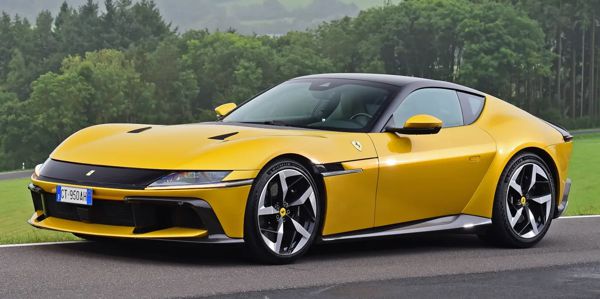
|
|
New
V12 model returns to its roots as a grand tourer like 550 Maranello... |
|
In 1996, Luca Montezemolo
revived Ferrari’s traditional front-engined V12 GT, a format preferred
by Enzo Ferrari, with 550 Maranello. Since then it evolved to 575,
599, F12 and 812, sitting at the top of Maranello’s production car
lineup. In this process, we saw noticeable changes to the character of
the V12 line, from grand tourer towards super sports car. This started
from the 599GTO, whose wider front tires traded understeer for
neutrality. F12 introduced a hyper-responsive steering rack with only
2.0 turns from lock to lock. F12tdf and 812 Superfast added active
rear-wheel steering for even sharper turn-in and greater agility. It is
incredible that a front-engined GT could be made so much like a
mid-engined supercar.
However, since the arrival of SF90, the V12 front-engined line is no
longer the flagship production car at Maranello. As highly developed as
the 812 Competizione, it is impossible to match the SF90’s hybridized
twin-turbo V8 for power and its mid-engined chassis for handling. As a
result, Ferrari needs to reconsider the market positioning of the V12
line. Now it returns to its roots as a grand tourer like the 550
Maranello, emphasizing more about comfort, refinement and easy to drive
manner, while still retaining the joy of naturally aspirated V12 motor
and very high performance. More towards the territory of Aston Martin,
you might say.
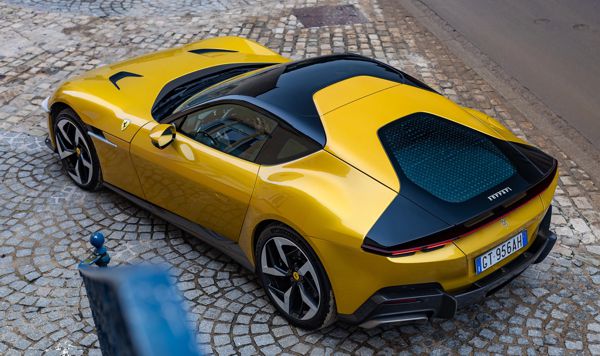
|
|
This
is the first time in the V12 line’s history that performance sees no
improvement...
|
|
The strangely named
12Cilindri is priced from £337,000, a whopping 33 percent higher
than 812 Superfast went on sale in 2017. However, it is no faster than
its predecessor, keeps
quoting 0-62 and 0-124 mph in 2.9 and 7.9 seconds, respectively, while
its top speed remains unchanged at "more than 211 mph". This is the
first time in the V12 line’s history that performance sees no
improvement.
Ferrari's engineers were busy making the 6.5-liter V12, codenamed
F140HD, comply with the latest Euro 6e emission standard and stricter
noise regulations. This involves new intake manifolds, ceramic
catalytic converters and particulate filters. To compensate, it adopts
the lightweight titanium
connecting rods from 812 Competizione, plus slightly lighter pistons
(by 2 percent) and camshaft (by 3 percent). This allows the V12 to rev
to 9500 rpm
like the Competizione and produce the same 830 horsepower at 9250 rpm,
but the flipside is peak torque dropping by 29 pound-foot to 500,
and it arrives 250 rpm higher at 7250 rpm. Fortunately, despite the
lower peak number, the torque curve looks in a healthier shape, as 80
percent of maximum torque is available from 2500 rpm upward, down a
full 1000 rpm from previously.
The 7-speed DCT gearbox has been updated to 8-speeder. It still rests
at the rear axle to enable a slightly rear-biased weight distribution,
although at 48:52 it is not quite as rear-biased as the 812 Superfast.
Final drive ratio has been shortened by 5 percent to compensate for the
lower torque. The first 7 gear ratios are unchanged, while top gear is
designed for fuel economy.
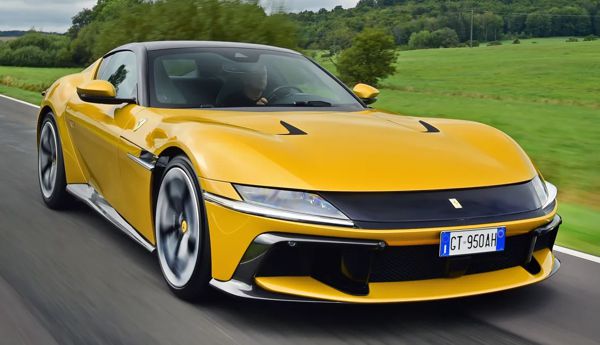
|
|
Pointy
"shark nose" is a tribute to the classic Daytona.
|
|
The 12Cilindri’s aluminum spaceframe chassis is developed
from the last incarnation. Its wheelbase is shortened by 20mm to boost
agility, but longer overhangs means its overall length is longer, while
it is also slightly wider and taller. Dry weight is up by 35 kg to 1560
kg, although Ferrari’s weight figures are not very reliable. Torsional
rigidity of the chassis is boosted by 15 percent.
The suspensions of 812 are kept, as is standard active rear-wheel
steering and active differential, but the new car rides on 21-inch
alloy wheels instead of the previous 20-inch items, so despite running
tires with the same width the traction and grip they produce should be
higher. The Side Slip Control program has been updated, while
conversion to brake-by-wire system should reduce stopping distances.
The new car is certainly more stylish than its predecessors. Its pointy
"shark nose" is unquestionably a tribute to the classic Daytona. The
shape of its headlights, signal lamps, the black panel bridging between
the headlights and the twin hot air vents on the front-hinged clamshell
bonnet are all so familiar to Daytona's lovers. However, the rest of
the car are quite different. Curvy fenders front and rear follow the
theme set by Roma and inject a sense of retro beauty not found in the
previous 812 family.
At the back, it is even a stark contrast to its predecessor. The
coupe's standard panoramic glass roof flows towards the small glass
tailgate, which graphically extends sideway to form a delta wing. Those
triangular black body panels at either side of the tailgate are
actually active spoilers, as they can be pivoted upward to generate
downforce. And this is balanced by the active flaps at the front
underbody.
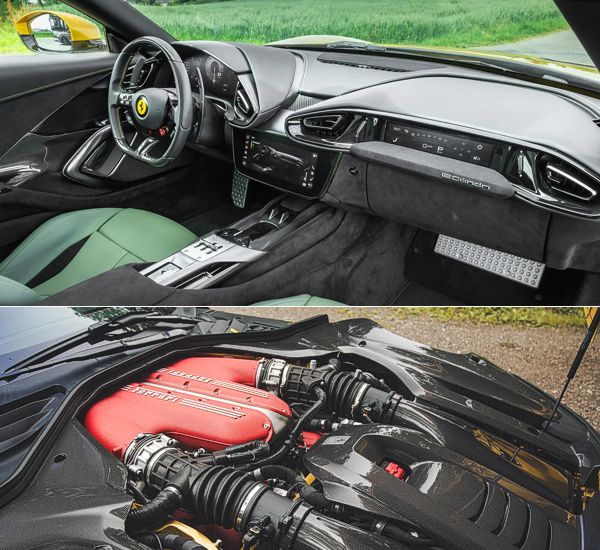 |
|
Sound
quality remains high, but it lacks the sharp edge of the 812.
|
|
As seen, from technical or performance point of view, the new car is
not a huge leap you would normally expect for a new generation Ferrari.
Its main objective is to keep the excitement of naturally aspirated V12
alive, while making the Ferrari flagship grand tourer more accessible
for everyday driving. The latter can be seen from an overhauled cabin,
which copies the twin-cockpit layout of Roma, sharing the steering
wheel, driver and passenger instrument displays with the smaller
Ferrari. However, the Roma's unloved 8.4-inch portrait touchscreen has
been replaced with a 10.25-inch landscape unit. The tinted glass roof
should give the cabin more sense of space, even though it comes at the
cost of kerb weight.
On the Road
As suggested by its name, the V12 motor is the highlight of the car. It
is one of the very few naturally aspirated V12s remain in production.
Smooth, free-revving and very responsive. It pulls from a little over
2000 rpm and spins effortlessly all the way to 9500 rpm. However, its
character has changed a little. Most obvious is the noise, which is
more cultured. Sound quality remains high, but it lacks the sharp edge
of the 812. It starts with a bark, then settles into the bassy
background as if a luxurious car motor. Cruising is a lot quieter,
which might fit the adjusted role of the car if not everybody’s
expectation. It takes 4000 rpm or higher to arouse its soul, yet the
noise builds up gradually, neither as dramatic nor as raucous as
previous Ferrari V12s, or Lamborghini’s unit.
Likewise, the power delivery becomes more progressive in the mid-range,
as Ferrari deliberately shaped its torque curve to rise linearly from
2000 to 7000 rpm at the most frequently used 3rd and 4th gear. The
12Cilindri is monstrous fast, of course, thanks in part to the ever
quicker shifts of its DCT, but its acceleration is also smoother and
easier.
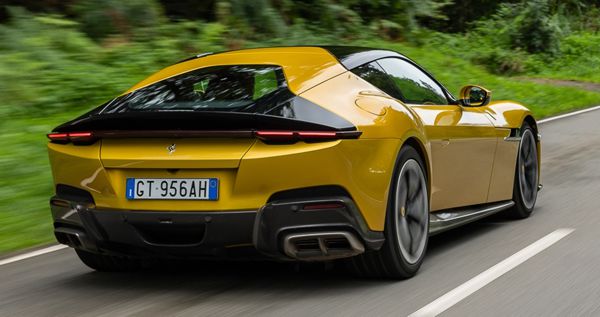 |
|
You
sit near the rear axle, but the car pivots around you, so it feels far
smaller than it is.
|
|
In corners, the more linear power delivery is put to good use, giving
you full confidence to meter out the amount of power to rotate the car.
The car understeers a little when approaching its very high cornering
limit. When it slides, it regains control swiftly, as the inherent
balance is so good and the SSC works seamlessly. Switch off traction
control doesn’t ruin its balance either – try this on an Aston Martin!
The steering remains ultra-direct, taking less than 2 turns from lock
to lock, but the car feels surprisingly calmer and more precise to
steer than the 812. You sit near the rear axle, but the car pivots
around you, so it feels far smaller than it is. Coupling to the immense
traction and grip, sharp braking pedal and instantaneous gearshifts,
the Ferrari’s handling is close to perfection for a front-engined
machine.
Meanwhile, it is a better grand tourer for everyday driving. The ride
is very good for a high performance car, made even more absorbent by
switching to bumpy road damper setting. The engine noise, road and wind
noises are also markedly reduced, making it a pretty good highway
cruiser.
While the haptic controls on steering wheel remain a nightmare to use,
you have the option of using the touchscreen to access most functions.
Storage space in the cabin is decent, including a parcel shelf behind
the seats. The boot is also large enough for a weekend’s luggage.
Unless you need rear seats, the 12Cilindri could perfectly replace the
outgoing GTC4.
Some may argue that it has lost the drama of 812 Superfast, but I
suppose the 12Cilindri just returns to the roots of Ferrari GTs. Sure,
Enzo built race-oriented cars like 250GT SWB or GTO that we still talk
a lot today, but the majority of cars he sold to customers were 250
Lusso, 275GTB, 330GT and Daytona. And they are hardly bad Ferraris.
|
Verdict:      |
|